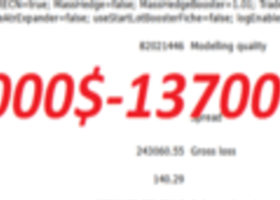
Deutsche Still See Dollar Resilient in 2016 Despite Rate-Wait
Strong fundamentals still make the dollar one of the best bets for 2016, despite recent back-peddling by the Fed; as for the pound – Deutsche see mega-downside potential.
Deutsche are still standing by their forecast for a stronger dollar in 2016 despite a step-change in Fed rate hike expectations since the beginning of the year.
According to the bank the only change in their strong-dollar forecast is in the amount of strengthening, not whether or not it will appreciate:
“We do not however believe recent macro developments should change a stronger USD directional bias, but the magnitude of future USD gains is now under constant review.”
Deutsche believe the markets have “priced-out” too much Fed tightening in the next few years and this will continue to provide underpinning support to USD.
Secondly a “panoply of easing measures will be pursued by the rest of the world in 2016.” And “Divergence as a theme is not dead.”
The third reason is what the Deutsche analysts describe as “rotation,” which refers to long-term up cyclical for the dollar versus other currencies.
In 2016 it is the turn of currencies which missed out on the dollar’s up-cycle in 2015, to weaken, such as sterling and the Swiss Franc:
“iii) Rotation. Last year we wrote “the strong USD rotation theme to continue, with the GBP, the Swissie, and NJA FX proving less resilient to USD strength in 2016”.
The see the dollar’s up-cycle as continuing to dominate for a long-time yet:
“As per our December comments we continue to believe that even a maturing USD trend could extend for another couple of years, but at a much slower pace.
“The USD real broad TWI is within 5% of fully recouping its prior cycle losses, but will achieve much stronger levels than the prior cycle peak, if China’s currency depreciation accelerates even modestly.”
Either Fed or China
Deutsche see more dollar gains as resulting from either of two main catalysts: either Fed policy or China slow-down.
“If Fed tightening is the driver, USD gains are seen as likely to be slow and broad-based, spread fairly evenly between G4 majors, commodity FX and EM FX.
“If on the other hand, China, particularly China FX policy becomes a source of instability, USD gains will be heavily concentrated in commodity and EM FX, while the majors all outperform”.
The research report goes on to describe four broad scenarios which describe the four probable ways in which dollar-centric markets could unfold in the next year.
The first is, “i) Fed hikes in the next 6 months;” followed by, “ii) Fed is on hold, but not too risk-off;” then, “iii) Risk-off dominates, led by non-US factors, like China;” and finally, “iv) Risk-off led by US, with expectations of Fed easing.”
Deutsche imply the scenario with the highest probability of evolving is i) “Fed hikes in the next 6 months,” which it points out is likely to be the most bullish for the dollar within its pairs.
Such a rate hike forecasts a fall in EUR/USD to 1.01, USD/JPY at 116.00, AUD/USD at 0.67 and USD/CAD at 1.40.
The note suggests “we might be in scenario two in the near-term,” and that we will probably either go ‘up’ to 1 or down to 3 in the next phase – which could happen very rapidly:
“One of the lessons we have learned from 2016, is we can oscillate rapidly between states, with no clear dominant risk-on/off state.
“Uncertainties related to China will likely remain the single most important restraint to a more positive risk environment.”
Sustained Dollar Losses Unlikely
Any weakness to the dollar is expected to be short-lived due to underlying strength in the economy:
“If ‘risk off’ comes from the US (e.g. weak US data) it can be USD negative, but only briefly!
“US consumer resilience should keep the economy growing.
"Balance sheet adjustments since the crisis leave the US economy better placed than other G10 economy’s to weather shocks.
“US led risk-off environment is unlikely to be a dominant state of the world.”
Fed rate hike expectations have now been reduced to only one hike in 2016 which means there is little scope for further discounting, and it is rare, “for Fed rate expectations to shift rapidly from a rate hike to rate cut (or vice versa).”
To get bearish the U.S Dollar the market would have to price in rate cuts, “inspired by U.S events,” and this accommodative Fed policy would have to not be matched elsewhere (which is unlikely given the pro-easing trajectory of most other major central banks).
“This should limit the USD’s downside under a worst case scenario; and, more likely provide significant upside if Fed rate hike expectations resurface.“
Outlook for EM and Non-Dollar G10
Deutsche also expects there to be a reactionary backlash in commodity currencies which it sees as having over-shot their recovery.
The note further argues that rate hikes in places such as Mexico prove that currency weakness has its limitations as a tool for economic growth (a point likely to be more dollar-negative than positive):
“A few currencies have reached the point where real economy benefits from currency weakness are negative.
“This is suggestive of a world where a countries asset markets, rather than currency may have to do more of the macro adjustment.
“At the margin it should start to constrain currency weakness.”
Likewise, the inverted market reaction to recent easing by the ECB and BOJ prove increases to QE have lost their novelty factor when it comes to manipulating the exchange rate.
The bank is euro-negative, due to banking concerns, the refugee crisis and potential knock-on effect or fallout from Brexit.
Deutsche now argue we have moved from a polar currency world in which the euro and dollar dominated, to a multi-pole currency world in which the Chinese renminbi is also a major force.
They see the yen as having topped and will probably appreciate from here in. This is partly due to their cyclical view of the dollar and the fact the yen hast been one of the hardest hit by the early part of the cyclical dollar strength.
On the pound the team are particularly bearish suggesting GBP/USD could depreciate by +/- 5% on the day of the referendum result.
“Our very weak GBP forecast (Cable1.15 in 2017) is much more than Brexit, but if the vote feels very uncertain going into the referendum, the currency could swing +/- 5% on the day.”
They finally describe the probability of continued pressure on USD-pegs unless the Fed turn-tail and start an easing cycle, which they see as highly unlikely.
PS: Copy signals and Earn on Forex4you - https://www.share4you.com/en/?affid=0fd9105


